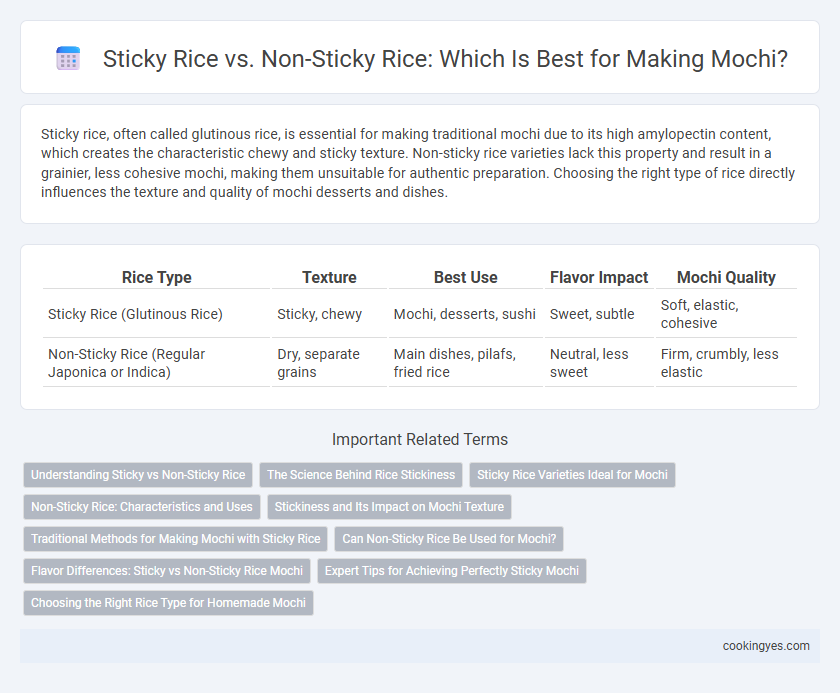Sticky rice, often called glutinous rice, is essential for making traditional mochi due to its high amylopectin content, which creates the characteristic chewy and sticky texture. Non-sticky rice varieties lack this property and result in a grainier, less cohesive mochi, making them unsuitable for authentic preparation. Choosing the right type of rice directly influences the texture and quality of mochi desserts and dishes.
Table of Comparison
| Rice Type | Texture | Best Use | Flavor Impact | Mochi Quality |
|---|---|---|---|---|
| Sticky Rice (Glutinous Rice) | Sticky, chewy | Mochi, desserts, sushi | Sweet, subtle | Soft, elastic, cohesive |
| Non-Sticky Rice (Regular Japonica or Indica) | Dry, separate grains | Main dishes, pilafs, fried rice | Neutral, less sweet | Firm, crumbly, less elastic |
Understanding Sticky vs Non-Sticky Rice
Sticky rice, also known as glutinous rice, contains higher levels of amylopectin, giving mochi its characteristic chewy and cohesive texture essential for traditional Japanese sweets. Non-sticky rice varieties, like short-grain japonica, have less amylopectin and more amylose, resulting in a firmer, less sticky consistency unsuitable for mochi's soft, elastic quality. Selecting the correct glutinous rice is crucial for achieving the desired stickiness and texture unique to authentic mochi preparation.
The Science Behind Rice Stickiness
The stickiness of rice in mochi is primarily determined by its amylopectin content, a highly branched starch molecule that gelatinizes upon cooking, creating a sticky texture essential for mochi's chewy consistency. Glutinous rice, also known as sweet rice, contains nearly 100% amylopectin and minimal amylose, making it ideal for producing the characteristic stickiness found in traditional mochi. Non-sticky rice varieties have higher amylose levels, which crystallize during cooling, resulting in grains that remain separate and unsuitable for the soft, cohesive texture required in mochi.
Sticky Rice Varieties Ideal for Mochi
Sticky rice varieties ideal for mochi include glutinous rice types such as Mochigome, known for their high amylopectin content that provides the characteristic chewiness and stickiness essential for perfect mochi texture. These rice grains gelatinize when cooked, creating a dense, cohesive mass that binds well and allows mochi to maintain its shape and softness. Selecting premium short-grain sticky rice enhances mochi's elasticity and flavor, making it indispensable for traditional Japanese rice cake preparation.
Non-Sticky Rice: Characteristics and Uses
Non-sticky rice, often referred to as medium or long-grain rice, has separate, firm grains that remain distinct after cooking, making it ideal for dishes requiring texture and grain integrity. This type of rice is less suited for mochi, which traditionally demands the glutinous, sticky qualities found in short-grain or glutinous rice. Non-sticky rice varieties are commonly used in pilafs, fried rice, and salads where fluffiness and grain separation enhance the dish's appeal.
Stickiness and Its Impact on Mochi Texture
Stickiness in rice varieties directly influences mochi's texture, with glutinous (sticky) rice providing the chewy and elastic consistency essential for traditional mochi. Non-sticky rice lacks the high amylopectin content necessary for this characteristic, resulting in a drier, crumbly texture unsuitable for mochi. The degree of stickiness affects the mochi's softness and stretchability, crucial for achieving the desired mouthfeel and structural integrity.
Traditional Methods for Making Mochi with Sticky Rice
Traditional methods for making mochi rely on sticky rice, specifically glutinous japonica varieties, due to their high amylopectin content which ensures the characteristic chewy and elastic texture. Non-sticky rice, lacking sufficient amylopectin, fails to achieve the cohesive consistency necessary for authentic mochi, resulting in a crumbly or dry product. The pounding process in wooden usu mortar further enhances the sticky rice's gelatinized starch structure, crucial for mochi's unique mouthfeel and flavor.
Can Non-Sticky Rice Be Used for Mochi?
Non-sticky rice cannot be used effectively for mochi because it lacks the high amylopectin content essential for the characteristic chewy and sticky texture. Mochi traditionally requires glutinous rice, also known as sweet rice or sticky rice, which gelatinizes and binds well during cooking and pounding. Using non-sticky rice results in a crumbly, dry mochi, failing to achieve the desired elasticity and smoothness.
Flavor Differences: Sticky vs Non-Sticky Rice Mochi
Sticky rice mochi offers a rich, chewy texture that enhances the sweet and subtle nutty flavor, making it ideal for traditional desserts. Non-sticky rice mochi tends to have a lighter, less dense mouthfeel with a milder flavor, allowing for more diverse fillings or savory adaptations. The difference in starch content between glutinous and non-glutinous rice significantly affects the flavor profile and texture, influencing the overall eating experience.
Expert Tips for Achieving Perfectly Sticky Mochi
For perfectly sticky mochi, use glutinous rice or sweet rice flour, as their high amylopectin content ensures optimal stickiness and chewiness. Soaking the rice for at least 4-6 hours before steaming enhances moisture retention, contributing to the desired sticky texture. Experts recommend steaming rather than boiling to preserve starch structure and achieve the classic elastic consistency essential for traditional mochi.
Choosing the Right Rice Type for Homemade Mochi
Choosing the right rice type is crucial for making authentic mochi, as glutinous rice, also known as sticky or sweet rice, provides the characteristic chewy texture essential for mochi. Non-sticky rice varieties like jasmine or basmati lack the high amylopectin content necessary for stickiness, resulting in a less cohesive dough. Using 100% glutinous rice or sweet rice flour ensures the ideal elasticity and mouthfeel for traditional homemade mochi.
Sticky vs Non-sticky for mochi Infographic

 cookingyes.com
cookingyes.com